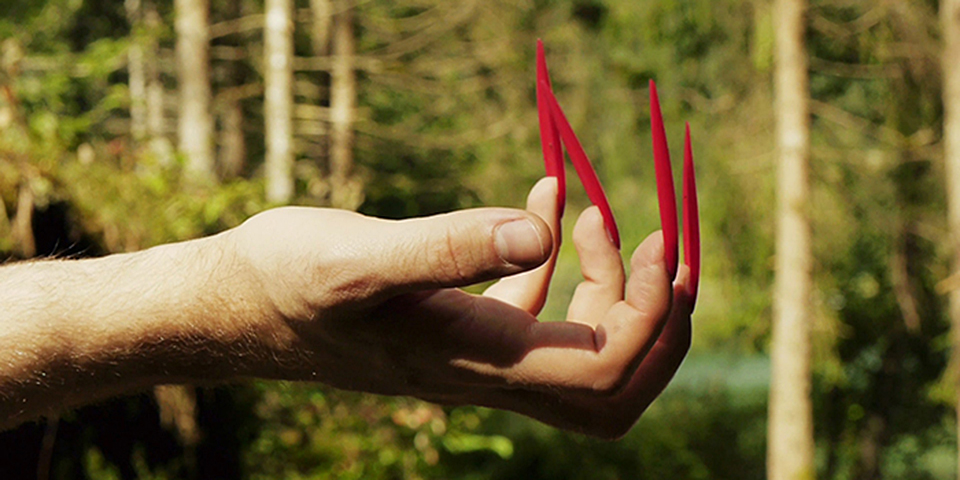
Jaakko Pallasvuo, Utopia, video (still), 2013. 6 minutes, 40 seconds. Courtesy of the artist.
Normal Reality
June 15 - September 9, 2015
Normal Reality presents twelve artists from the U.S., Canada, and Europe, whose embrace of popular digital technologies raises questions about normalcy in the age of accessibility. Video art as a medium began in the mid-1960s with the advent of portable cameras and recorders, which, though cumbersome and expensive, offered a limited number of artists a new tool for exploring issues of time, space, language, and the body—with an immediacy not possible with film. As video technology advanced to camcorders in the 1980s, "effects processing" facilities still had to be rented by the hour for anyone trying to use digital effects and edits with any level of sophistication. Now, many of us carry high-definition smartphone cameras in our pockets, with fairly easy access to the limitless possibilities of cutting-edge editing software.
The artists featured in Normal Reality are guided by the exploratory concerns laid out by early video practitioners, but the environments they navigate are accessed largely through a multilayered and ultra-fragmented media experience of gaming, 24/7 Internet access, social media posting at a stoplight, and GPS. This experience is a given: digital reality is reality, Facebook is our forum, and posting pictures of where we are and what we are eating is increasingly how we define ourselves.
Sparkling I by Petra Cortright (Los Angeles) is one of twelve videos in the exhibition exemplifying this "normal reality." Performing in front of a built-in webcam with preset digital effects, Cortright nonchalantly waves a tree branch like a magic wand that dissolves into sparkling star effects, accompanied by the most clichéd synthesized fairytale-like soundtrack. Her digitized body's real-time oscillation between actual motions and their dematerialization into a virtual realm hits home the increasing displacement of actual nature by our experience as measured on screen time.
In Jaakko Pallasvuo's (Helsinki) video, Utopia, the artist/narrator dispassionately relates, in the manner of a director's commentary on a DVD, his failure to capture in video-as opposed to language-the essence of an idyllic Swedish landscape we view on the screen. Cutting to his small Finnish apartment where he edits on a laptop whose screen we view face-on, his interspersing of Japanese emoticons and clip art implies that the video he shot is no more capable of capturing the Sublime than emoticons are of expressing actual emotion. As the sequence quickly cuts back to him walking into an expanse of mountain peaks and lush greenery, his voiceover states "...Maybe it felt as unreal as it looks."
In Realm of Nothingness, Kathy Rose (New York) integrates dance, theater, and cinematic features into a dream-like narrative which draws parallels between tradition and hi-tech. Her audio and editing mimicking the rhythm and choreography of Japanese Noh theater, she holds true to the traditional storytelling about masks as a means of transformation between supernatural and human forms. In Rose's case, the masks are not made from Japanese Cypress but from digital collage, and the theater is not a hardwood stage but a black video screen on which the characters can pop in and out between reality and illusion.
The nine other videos in the exhibition are: Everything Becomes X-Ray by Mariam Graff (Fairview, Illinois), The Realm of Nothingness by Rosa Menkman (Arnhem, Netherlands), MindPlace ThoughtStream by Shana Moulton (New York, NY), central~lattice by Brenna Murphy (Edmunds, Washington), The Land Behind by Sabrina Ratté (Montreal), Implicit Bias—ghost in the shell by Wolfie E. Rawk (Chicago), Island Light by Andrew Rosinski (Chicago), QTzrk_loop by Jon J. Satrom (Chicago), and floVV by Małgosia Woźnica (Warsaw).
This project is organized by University Galleries’ Curator Jason Judd, and is supported in part by the Illinois Arts Council.
Additional Programming
Milner Library
University Galleries is partnering with Milner Library to display 12 videos from Normal Reality on a large flat screen television in the stairwell on the third floor landing during all hours of operation August 3 through October 12.
ACRE TV
University Galleries is collaborating with ACRE TV to broadcast videos from the artists in groups of three, producing four weekly segments between August 5 and August 31.
Events & Programming
Curator lecture
Normal Reality: Internet Aesthetics, Digital Bodies, and Accidental Audiences
Wednesday, September 2
4:00 p.m. - 5:00 p.m.
Closing reception
Wednesday, September 2
5:00 p.m. - 7:00 p.m.
Video screenings
Milner Library
August 3 - October 12
ACRE TV
August 5 - 31
